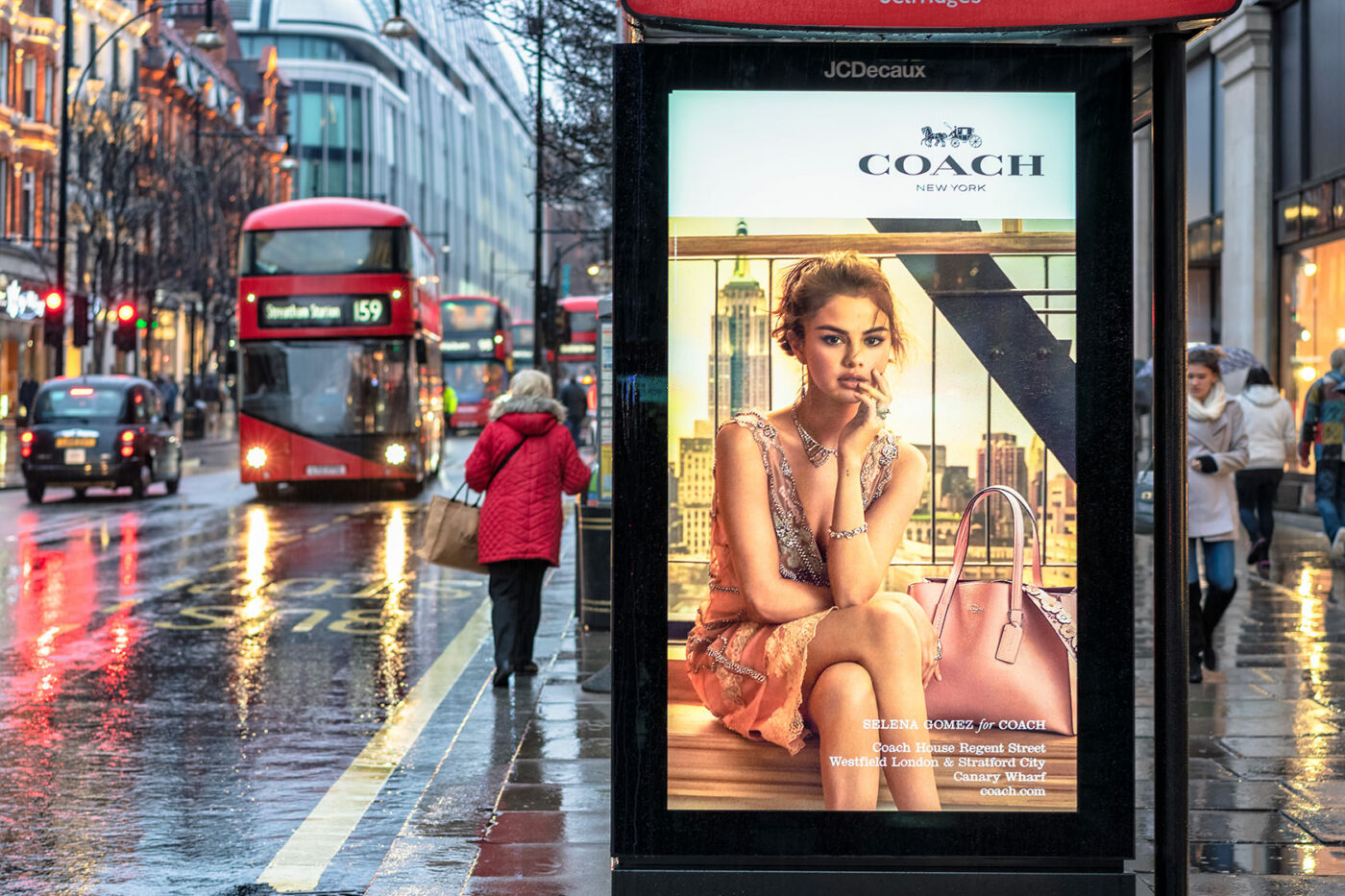Digital out of home marketing offers many opportunities to engage with consumers as they navigate the world throughout the day. Our computers, our televisions, our phones—all are touchpoints providing channels for DOOH advertising. As consumers move through their day, they are also physically moving through the world. When consumers are on the go, the number of channels available to reach them drops, limiting marketers to out-of-home and mobile media.
Luckily, digital out-of-home (DOOH) advertising provides a powerful way for marketers to engage consumers at points in the day when other channels aren’t available, surrounding consumers with messaging throughout the day. Whether large format screens or displays seamlessly integrated in contextually relevant environments, out-of-home is a high-impact format for reaching consumers. Most DOOH venues support rich media creative formats, for highly engaging customer experiences.
Understanding the DOOH Advertising Landscape
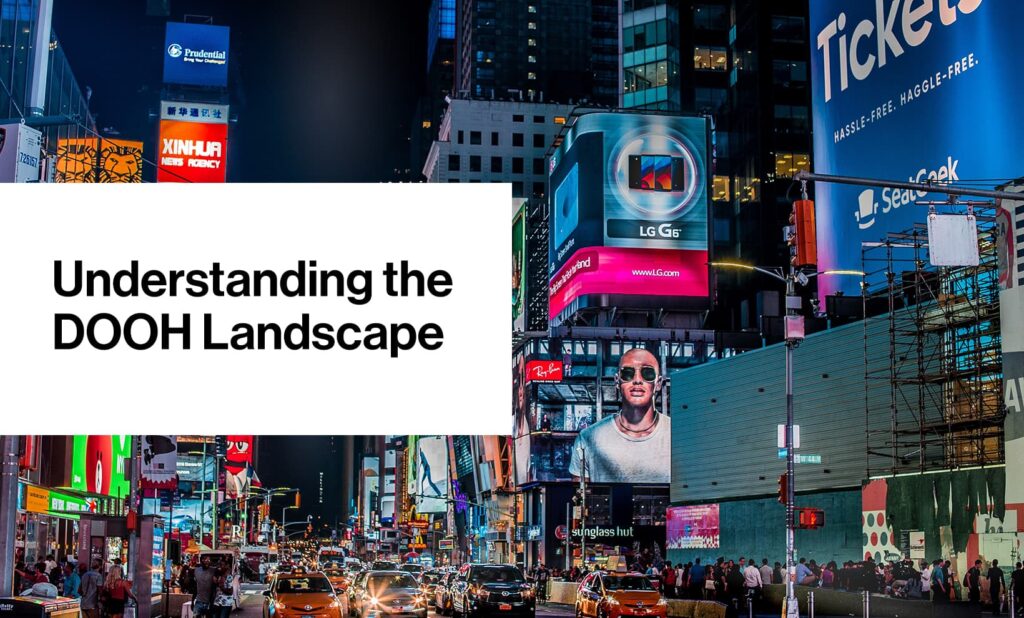
Digital out-of-home media generally falls into two categories: place-based media and large format out-of-home.
PLACE-BASED MEDIA
Place-based displays encompass a wide variety of formats that are specially located where consumers congregate for a variety of purposes. These displays allow marketers to reach consumers in contextually relevant environments, such as malls, gyms, office buildings, restaurants & bars, taxis and more. Our network can connect these locales to reach consumers at multiple touch points throughout their days.
LARGE FORMAT OUT-OF-HOME
Large format out-of-home displays can include billboards and other large displays. These standardized large format advertising displays are intended for viewing from extended distances, generally more than 50 feet. Street furniture such as bus shelters and kiosks are also large format advertising displays, but they differ from billboards in that they provide a public amenity, and are positioned in close proximity to pedestrians and shoppers for eye-level viewing, or at curbside to influence vehicular traffic.
Building Audiences for DOOH Advertising
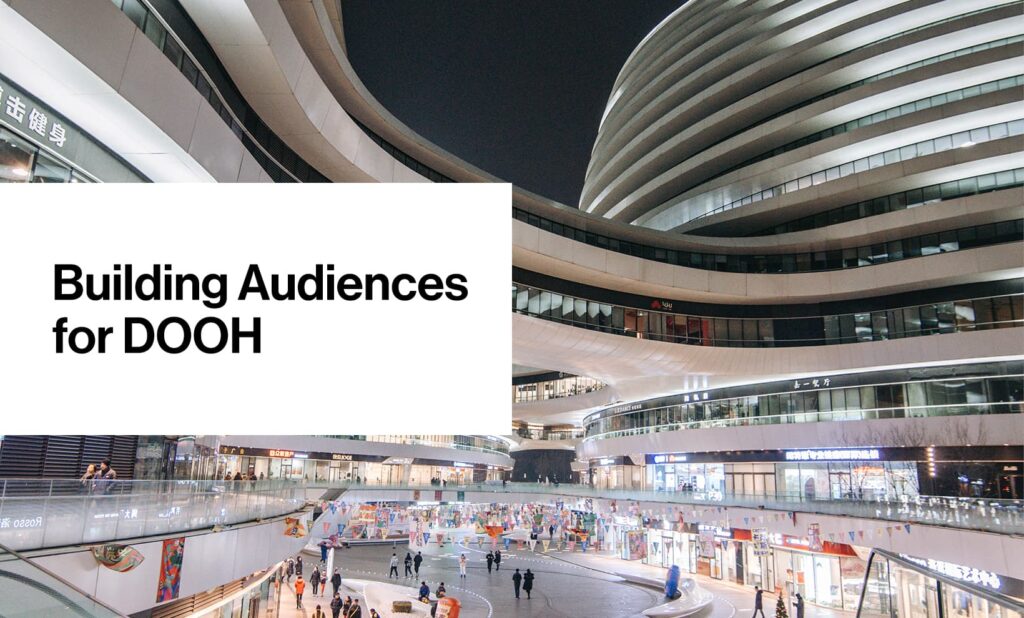
The first step to finding the consumers you want to reach is understanding the meaning of locations that people visit. Is it a daily stop at the local coffee shop on the morning commute to signify a coffee drinker? Or is it a trip to the video game store to pinpoint a gamer? The locations consumers visit define who they are.
DOOH audiences are built using data about past visitation patterns to points of interest, in order to build the most accurate and precise audience profiles in the DOOH space. For example, an audience of “Frequent Coffee Commuters” might be based on people that regularly visited coffee shops and transit stations during the morning commute hours.
Think of this data like a cookie – instead of looking at people who visit coffee-related websites, DOOH takes a “real-world” approach, identifying the audience that physically visits coffee shops, retailers, etc.
In order to take advantage of movement-based targeting, it is recommended to target campaigns across multiple venue types. While there are some specific execution scenarios where a single venue type campaign makes sense, the majority of campaigns see greater success when spanning multiple touchpoints in a consumer’s journey, across a variety of venue types.
Advanced Targeting Capabilities with DOOH
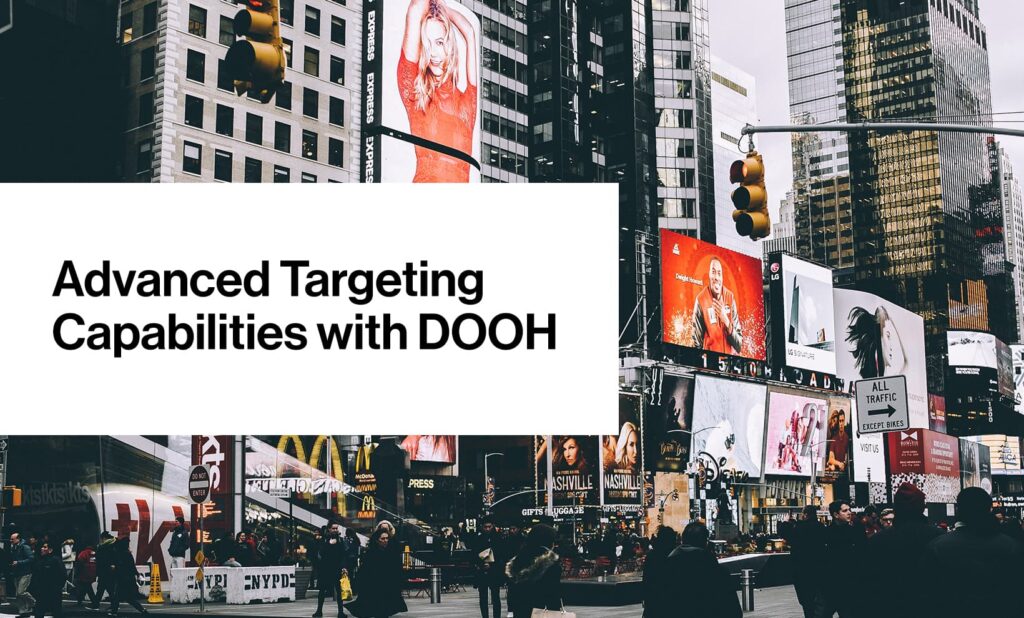
For marketers looking for more advanced targeting capabilities such as vertical-specific audiences and weather triggering, there are certain 3rd-party data partners that we can rely on.
Liveramp: By ingesting your CRM data to build customer profiles, including Device-ID based audiences, you can target loyal and competitive audiences.
The Weather Channel: WeatherX triggers include hot, cold, severe weather, rain, snow, and air quality/pollen index.
IHS Markit (fka Polk Automotive): Leverages IHS’ predictive algorithms against the DMV database, matching this behavior with in-market households.
Kantar/Shopcom: Use CPG-specific audiences based on Kantar’s shopper data based on past transactions.
Ibotta: More CPG-specific audiences based on data from Ibotta’s mobile shopping app that collects purchase information from users’ linked loyalty cards and uploaded receipts.
Understanding Measurement for DOOH Campaigns

Because DOOH campaigns don’t take place on a user’s individual device or browser, tracking and measuring the success of these campaigns is a bit trickier than other digital marketing channels such as display or video. But measurement of DOOH campaigns is still possible! Here are three different ways we can measure the effectiveness of your digital campaign.
- Brand Lift Study: A brand lift study measures lift in upper funnel brand metrics generated by ad exposure. Typical brand metrics include brand awareness, consideration, purchase intent, brand favorability, and other indicators of consumer attitude toward a brand. These studies measure lifts in brand metrics by serving custom mobile surveys to exposed consumers, allowing brands to get consumer input on indicators custom-tailored to campaign goals.
- Foot Traffic Study: A foot traffic study measures lift in visits to a brand’s brick-and-mortar locations driven by ad exposure, reflecting the impact of out-of-home advertising on consumer behavior.
- Sales Lift Study: A sales lift study measures lift in consumer purchases of a brand’s products and services attributable to out-of-home ad exposure. Vistar has access to specialized vertical solutions that tie sales data to the household level, enabling sales lift measurement for automotive and CPG clients.
Buying Strategies with Digital Out Of Home Campaigns

There are a number of different buying strategies available to marketers for DOOH campaigns. Each of these approaches has benefits for specific situations.
Open Exchange Buying
Deals executed through the open exchange offer the most robust audience targeting capabilities with massive scale. This buying approach allows marketers to leverage the full scale of digital out of home inventory to reach the right person at the right time. Using a data-based approach, buyers can mirror programmatic strategies from other digital channels. Open exchange programs are non-transparent (visibility is limited to venue type) and non-guaranteed (all impressions are biddable and no spend commitment is made.)
Private Marketplace Buying
Private Marketplace Deals allow marketers and media owners to directly negotiate customized subsets of inventory to execute programs. This provides similar targeting capabilities to open exchange, but refined down to a specific list of screens at a pre-negotiated price. This approach is best suited for buyers who wish to limit their campaign to a curated list of media owner inventory. PMP programs are transparent (visibility of media owners and screens) and non-guaranteed (all impressions are biddable and no spend commitment is made).
Direct Buying
Executing a deal directly with a media owner provides transparent and guaranteed inventory. This approach makes sense for buyers with very specific execution needs, such as a custom experience offering built with an individual media owner or 100% SOV on a handful of specific screen locations. Direct buyer programs are transparent (visibility of media owners and screens) and guaranteed (all impressions and spend are committed upfront for each screen).
DOOH Targeting Approaches
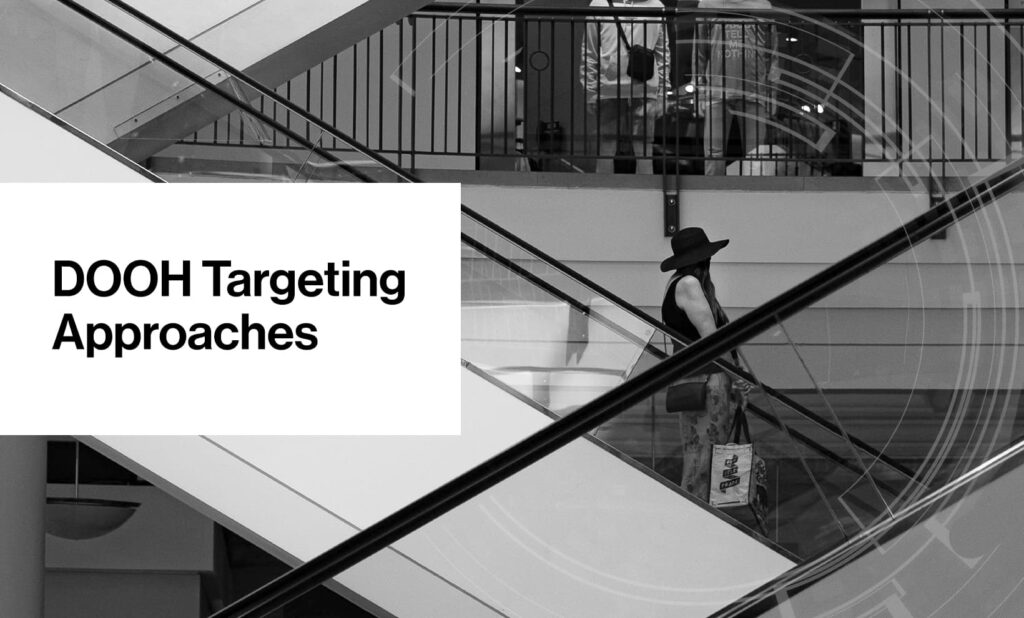
Proximity Targeting
One of the easiest ways to leverage targeting for success in DOOH is to build audiences based on individuals who have been to a specific store or place of interest. Applications of proximity targeting include:
- Reaching an audience of shoppers who have visited the client’s stores in the past month
- Targeting individuals that have visited a competitor’s location within the past month
- Using a relevant 3rd-party point-of- interest to find relevant consumers. For example, an insurance provider might target an audience of individuals who have visited doctor’s offices.
Audience Extension
Instead of the traditional out-of-home approach of cherry-picking specific inventory for monthly buys, our access to a unique combination of supply partners across different venue types and audience targeting capabilities helps brands extend their existing audience strategies. Through Device-ID targeting, brands can reach the same customers in the offline world as they are targeting online. For example, a brand already targeting NFL fans in digital can extend that audience to deliver tailored messaging across gyms, office buildings, bars and billboards.
Behavioral Audience Targeting
In online marketing channels such as display and video, browser-based cookies allow marketers to use consumer behaviors to define relevant audiences for targeting. In digital out-of-home, we use real world signals to recreate the same type of behavioral audiences. For example, an audience of “Regular coffee commuters” might be based on individuals that visit a Starbucks store 3+ days per week and transit locations during morning and evening rush hours.
Executional Techniques for DOOH
DOOH is not a one-size fits all channel, and as time goes on, the tactics have continued to evolve and become more creative. We have broken down most DOOH campaigns into one of three buckets below, but each of these can be combined with other techniques.
- Linear (Static or Video Ad): Most DOOH is linear, and comes in the form of either a static display or animated video ad.
- Dynamic Creative Optimization (DCO): This technique updates the ad based on different data and conditions.
- Interactive: This is where marketers have a chance to really shine with creative and memorable experiences. There are a wide range of technologies available for interactive DOOH, including:
- Touch: Touch screen displays for physical interaction with the ad
- Gestures: Relies on infrared technology to interpret gestures into the ad
- Recognition: Tailors content based on who is looking at or near the ad
- Camera-Based: Users interact with a camera for user-generated and shareable content
- Mobile: These rely on smartphones to interact with the display
DOOH Campaign Best Practices

As with most programmatic media, programmatic digital out-of-home inventory is not guaranteed. To ensure successful campaign execution and full budget delivery, there are a few important factors to keep in mind.
- Target 3+ Venue Types: Don’t limit your campaign to a single venue type. In order to successfully reach your consumer across multiple touch-points throughout their day, it is recommended that you include 3 or more venue types. Leveraging a multi-venue strategy dramatically increases the impact of campaigns.
- Keep Budgets Fluid: All programmatic inventory is non-guaranteed, so it is advised to keep budgets fluid across venue types to maximize reach. With a fluid budget setup, you can easily shift impressions to available inventory across different venue types as needed and to optimize toward high performing areas. As with venue types, keeping budgets fluid across markets provides flexibility to reallocate spending to ensure campaign goals are still met even as conditions may change.
- Embrace the Technology: DOOH is no longer just a digital poster, although 90% of DOOH ads are still running on a 10-20 second linear loop. If you want to get your message noticed, it might be time to think outside the box and embrace the amazing technology available.
- Think Integrated: Great DOOH campaigns are ones that sit comfortably within the wider brand strategy and capture the imagination. No marketing tactic should sit in a silo, and DOOH is no exception.
Get the Guide: 5 Steps to Prepare for the Loss of Third-Party Cookies
In preparation for what’s to come, we’ve created a guide with 5 ways to plan your programmatic advertising strategy without the use of third-party cookies.
Fill out the form below to download the guide.
